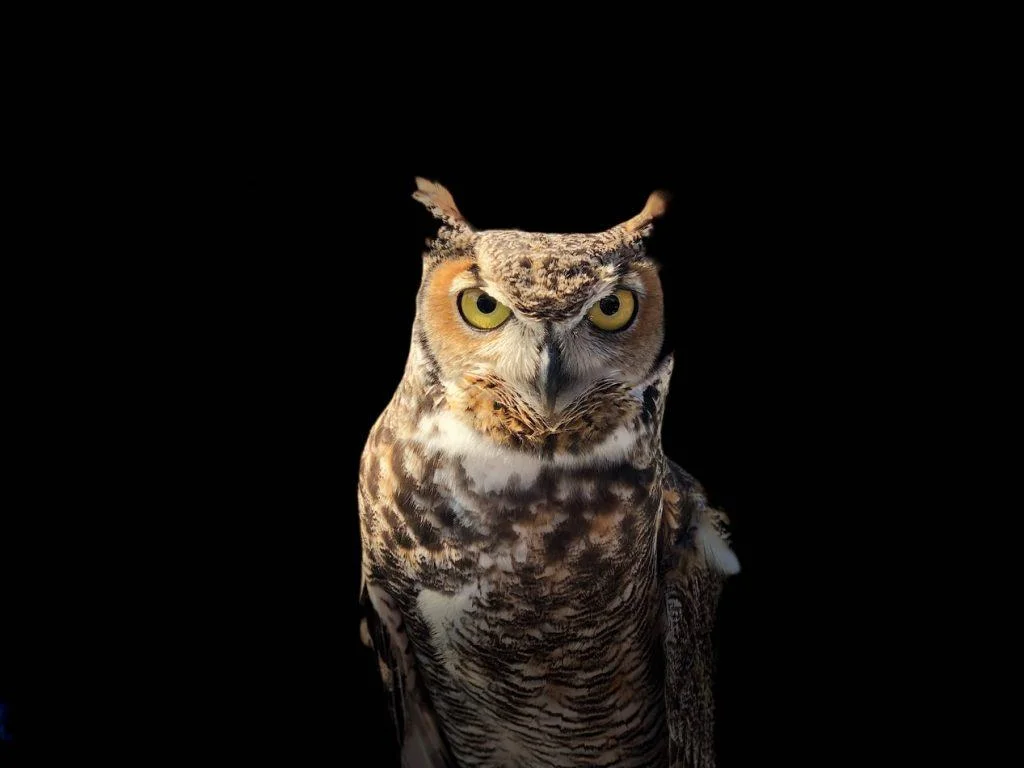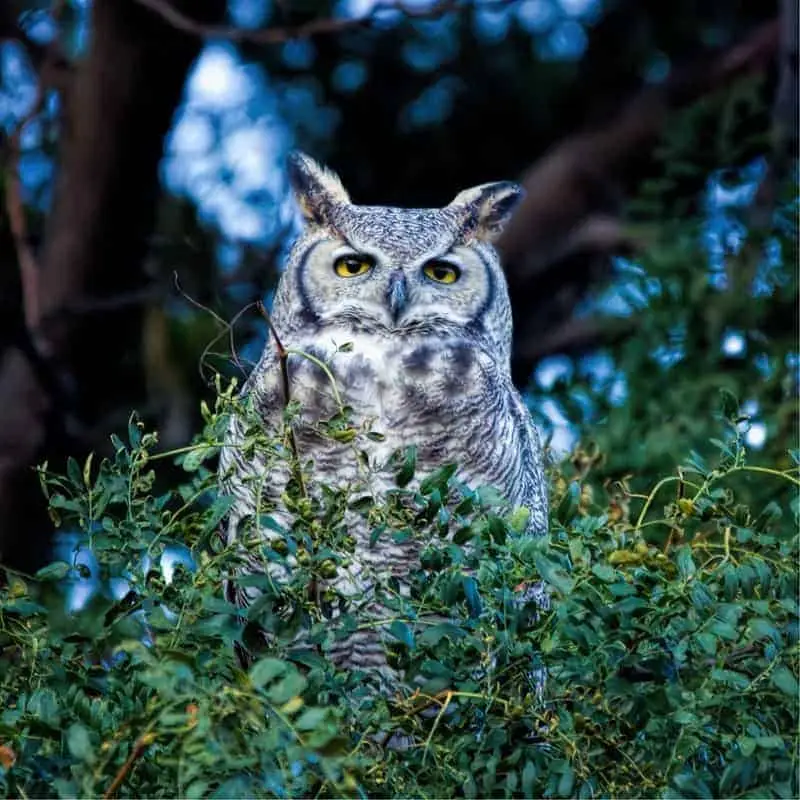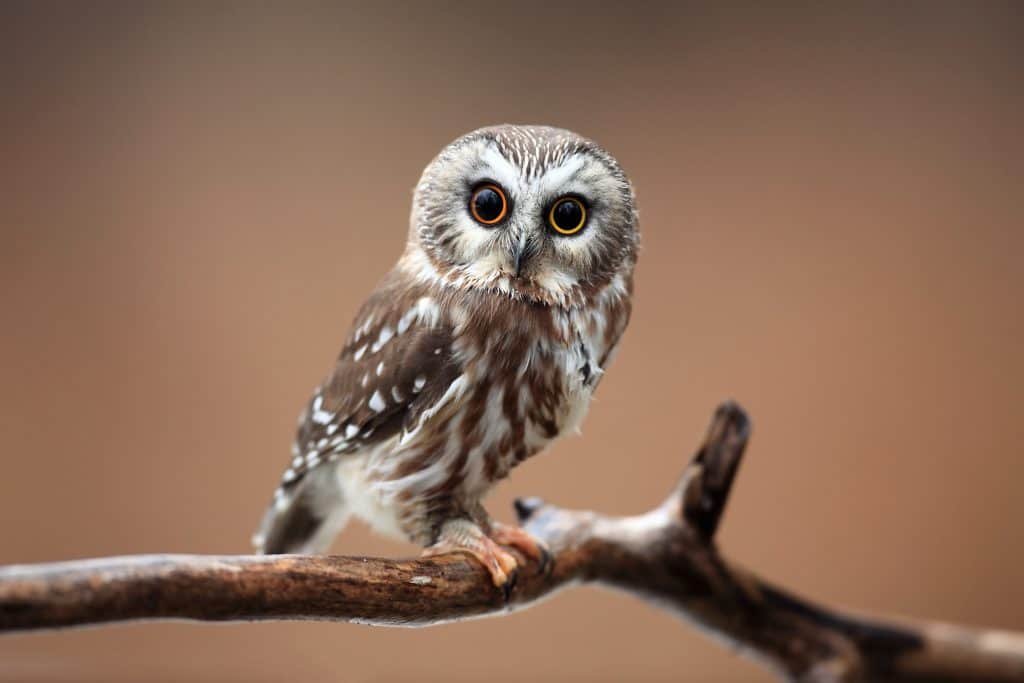
Tennessee is a beautiful and open land that is filled with stunning natural attractions and a wide variety of wildlife.
This beautiful state has plenty to offer its local residents, human and animal alike, and it is a much-loved space because of it. One animal that takes up residence here frequently is the owl.
Currently, Tennessee is frequented by a total of eight notable owl species, making it a great state to spot these exciting nighttime birds if you are interested.
Fortunately, this state has a variety of different habitats and benefits to offer the local owls.
Want to learn more? This National Geographic Book on Owls is a great read!
Tennessee is known for its temperate climate that offers warm summers and mild winters.
This beautiful state has a nice enough weather pattern to allow for a variety of residential and nomadic owl species that have been known to grace the skies and dazzle the local residents.
Since it offers so many different natural areas, there are regions to support owl species of all kinds, making it a great place to owl watch.
Whether you are looking for a residential owl or a seasonal one, you might be in luck in this charming state if you are willing to spend some time outside.
The state of Tennessee has a collection of beautiful State Parks known to play home for many animals, including owls of all shapes and sizes.
As long as you know where to look, you can easily find a variety of exciting owl species not too far from your home.
Want to attract Owls to your yard? Take a look at our article!
What Owls can be seen in Tennesse?
Table of Contents
1. Barn Owl

Wingspan
107 to 110 cm
Weight
430 – 620 g
Life Expectancy
Up to 4 years
Diet
Voles, Shrews & Mice
The barn owl is a native resident in Tennessee that can be easily spotted if you know where to look.
These courageous birds can seem massive with their long wingspan and tall build, but they are distinctly more interested in hunting small animals rather than bothering you.
If you are looking for barn owls, simply look for the white figures soaring through open spaces in the night. They can be heard with their shrill call in the night and are known to mate for several seasons with the same owl partner.
The barn owls in Tennessee are known to be a little more open-minded than barn owls in other states when it comes to living spaces.
These birds can be found along forest edges, near meadows, in fields, and even in towns. These ghostly white figures are even known to frequent local cemeteries near wet areas.
These favored owls can be seen in Tennessee all around the year, but they are known to spend time nesting in Spring and Fall, so you might have a better chance of spotting one of their unique couplings then.
These wonderful birds are known to spend time out looking for food around sunup and sundown, so try venturing out during these hours if you suspect there might be some nearby.
2. Eastern Screech Owl

Wingspan
46 to 61 cm
Weight
160 g
Life Expectancy
14 years
Diet
Rats, Squirrels, Rabbits & Skunks
The Eastern Screech Owl is a mottled owl with feathers that tend to be grey or brown mixed with white.
They can be easily recognized a lot of the time because they tend to be smaller than a lot of other owls in most areas.
However, they are still skilled hunters and can be found sleeping in a nice hole in a tree or soaring through the sky at night. Their signature call involves a descending sound that many people consider to be unique.
Though you are more likely to hear one of these owls than see them, they are common enough to make seeing them a distinct possibility.
Since they do not migrate, it is common to find them continuously in an area, so your chances of seeing one are even better.
They are known to be seen around forests, near suburban spaces, and in the wetlands.
Eastern Screech Owls like most owls are nocturnal, so it is easier to spot them at night.
Your chances might be increased during mating season in the spring, but the best time will always be during their hunting hours just after the darkness settles in.
These adorable owls are known to stay hidden, but you can also see them during the day tucked away in trees from time to time.
3. Great Horned Owl

Wingspan
~140cm
Weight
1.4 kg
Life Expectancy
28 years old
Diet
Squirrels, Rabbits & Skunks
The Great Horned Owl is a magnificent species of owl known for its large size and intimidating horn-shaped feathers that rest atop its head.
Many people find this owl to be quite a sight to marvel at. These unique birds often nest in nesting sites that have been stolen from other birds and are generally found perched high in trees for their nesting rituals.
Their large size makes them fairly easy to spot.
The Great Horned Owl nests in late Fall and early Winter in Tennessee making it fairly easy to spot during these times of activity.
These owls are known to inhabit a great many areas including forests, marshes, and fields. You can see them resting throughout the day up in stolen nests in trees or flying by at night as they hunt small mammals.
These owls are known for their characteristic love of dusk. Unlike other owls that wait for the dark, the Great Horned Owl is known for heading out in broad daylight if it sees something particularly delicious.
You can generally see these birds out and about as the sun goes down.
With their large size, you can spot their silhouettes around sundown. Simply look for the bright yellow eyes in the darkening light.
4. Barred Owl

Wingspan
107 and 111 cm
Weight
720 g
Life Expectancy
23 years
Diet
Birds, Fish, Reptiles
Though it is smaller than the Great Horned Owl, the Barred Owl is a competitive bird that enjoys hunting and a nice midday nap.
With its nests that are often tucked away in the trees, you can expect to see them nestled away in tree cavities during the day.
However, these birds are plenty active at night and are known for being adept hunters who are willing to chase down just about anything that moves if it is small enough.
The barred owl is easy to spot in Tennessee because it is the only local owl with dark eyes.
These birds, which can be found facing off with the Great Horned Owl in some areas, is known for its unique habit of being present during the day, making it much easier to spot than some of the other common owls in the area.
You can find them around Tennessee in a wide range of woodland areas including state parks, and they are fairly common in the middle of Tennessee.
Since the Barred Owl is known to spend time flying around during the day, you might have a good chance of seeing one if you head out for a stroll through the right kind of habitat.
If not, you can always look near woodland areas in the night when small mammals and reptiles spend time scurrying across the bottom of the forest floor.
Their numbers increase in Spring and Summer due to mating rituals.
5. Long-Eared Owl

Wingspan
90 to 100 cm
Weight
250 g
Life Expectancy
4 years
Diet
Small mammals, mice, rats & rabbits
The Long-Eared Owl is an owl that is hard to miss simply because of how enormous it is.
This particular owl is known for its massive size with a wingspan that can reach up to three feet.
Many people consider this nighttime predator to be a bit on the scary side given its large size, but it has no interest in heckling humans.
However, these large birds won’t think twice about taking over another bird’s nest to start a family of its very own. With its fun songs and stunning air displays, these owls stop at nothing to find a good mate.
Long-Eared Owls can be found in areas with plenty of vegetation. Though they aren’t the most common owl in Tennessee, you can see them if you find a place that has plenty of them to eat.
They enjoy dense cover and brush because it generally houses plenty of small prey that they can scoop up and eat.
If you live near a good rich prairie or forest area with plenty of flight room, you might be in luck.
These birds are known for their nocturnal activities and will generally be hidden away completely during the day.
However, when night comes out, don’t be surprised if you see a large form descending on the brush below to snatch up a delicious meal to eat.
They mate between Winter and Spring, making this a good time to spot them as they head out to win over a sweetheart and start a family.
6. Short-Eared Owl

Wingspan
85 to 110 cm
Weight
206–475 g
Life Expectancy
4-12 years
Diet
Voles, Mice, Squirrels
This dark nomadic owl is known for its unique physical appearance and peculiar migratory patterns.
If you live in the mid to southern United States, you will only see this beauty seasonally, but it does like to spend plenty of time in Tennessee.
These unique birds spend time in safely covered nests on the ground and enjoy hunting for smaller prey.
Their dark feathered forms make them stand out among the other owls. These medium-sized owls have distinctly round heads and short tail feathers too.
The Short-Eared Owl primarily visits the west and middle regions of Tennessee.
These areas offer the right kind of habitat including brush, open fields, and other fun areas for these darling birds to spend time building nests.
You can easily spot them hunting on the ground, and they are most easily noticed because of their bizarre flight patterns.
Short-Eared Owls fly low above the ground in awkward and irregular patterns.
These feathered friends are most commonly seen in the cold months, particularly November through January, and are frequent visitors to Tennessee.
You can spot them when they head out hunting, which they generally do in low light rather than outright night. Like most owls, they remain tucked in during the day for the most part.
7. Snowy Owl (Rare)

Wingspan
150 cm
Weight
2 kg
Life Expectancy
10 years
Diet
Birds, Rabbits, Fish & Rodents
When you see this unmistakable snow white owl, you will recognize them immediately.
These unique birds, which are most commonly found in Alaska and Canada, have been known to venture far and wide and surprise many a bird watcher.
Their distinctive white feathers make it obvious to anyone who sees them that they are out of their natural element when you see them down south, but it does happen from time to time.
These birds are known for nesting on the ground and for their monogamous relationships. However, two females have been known to take up with the same male in the event that there is enough food around.
Finding one of these owls in Tennessee is nothing short of a miracle sighting.
The Snowy Owl generally doesn’t go much further south than Canada, but that doesn’t mean that you can’t spot one out in the open if you are lucky.
You will find these birds flying anywhere over the state when they stop by for a snack, but very few venture that far south.
If you are lucky enough to see a Snowy Owl, it is almost always going to be in Winter.
These migratory birds have been known to fly south during this time, but they generally don’t go too far south because they like the cold and are well built for it.
You can spot them out during the day or night if you are lucky enough.
8. Northern Saw-Whet Owl (Rare)

Wingspan
40 - 60 cm
Weight
100 g
Life Expectancy
7 years
Diet
Small birds, young squirrels, voles & shrews
The Northern Saw-Whet Owl is a beautiful brown owl that is known to spend time nesting inside small and comfortable cavities.
While a nice tree cavity will do, they are also known to take over woodpecker holes and enjoy building their nests tucked away from natural predators, including other owls.
These unique birds generally call out in quick succession, making it easy for you to know when one is around.
Finding the Northern Saw-Whet Owl is a feat by itself. Though these birds do spend plenty of time in Tennessee, the fact is that they generally live where humans don’t spend too much time.
These birds favor high trees and deeply wooded areas that are home to a wide range of smaller mammals that they can eat.
When you aim to see the Northern Saw-Whet Owl, you will need to venture out into the cold dark night.
These nocturnal birds only hunt in true dark and since they only visit Tennesse in Winter, it is generally fairly cold out when you get to see them.
Spotting one of these elusive owls means taking the time to head out into the forest and listen for their call.

More Articles.

How To Attract Birds Of Prey To Your Yard?
The best way to attract birds of prey into your yard is by creating a

How to Attract Doves to your Yard?
Doves are beautiful birds with many sentimental attachments. Most people affiliate doves with positivity, love,

Best Hummingbird Feeders for 2020
Nectar bird feeders are well-known for attracting a variety of adorable birds and for saving

About Us
We are avid bird-watchers who recently retired, allowing us more time to travel the world. Fortunately, we have managed to visit numerous countries around Europe, Asia, and America. Watching and photographing birds has been a passion for many years and we are making the most of the extra time on our hands!
